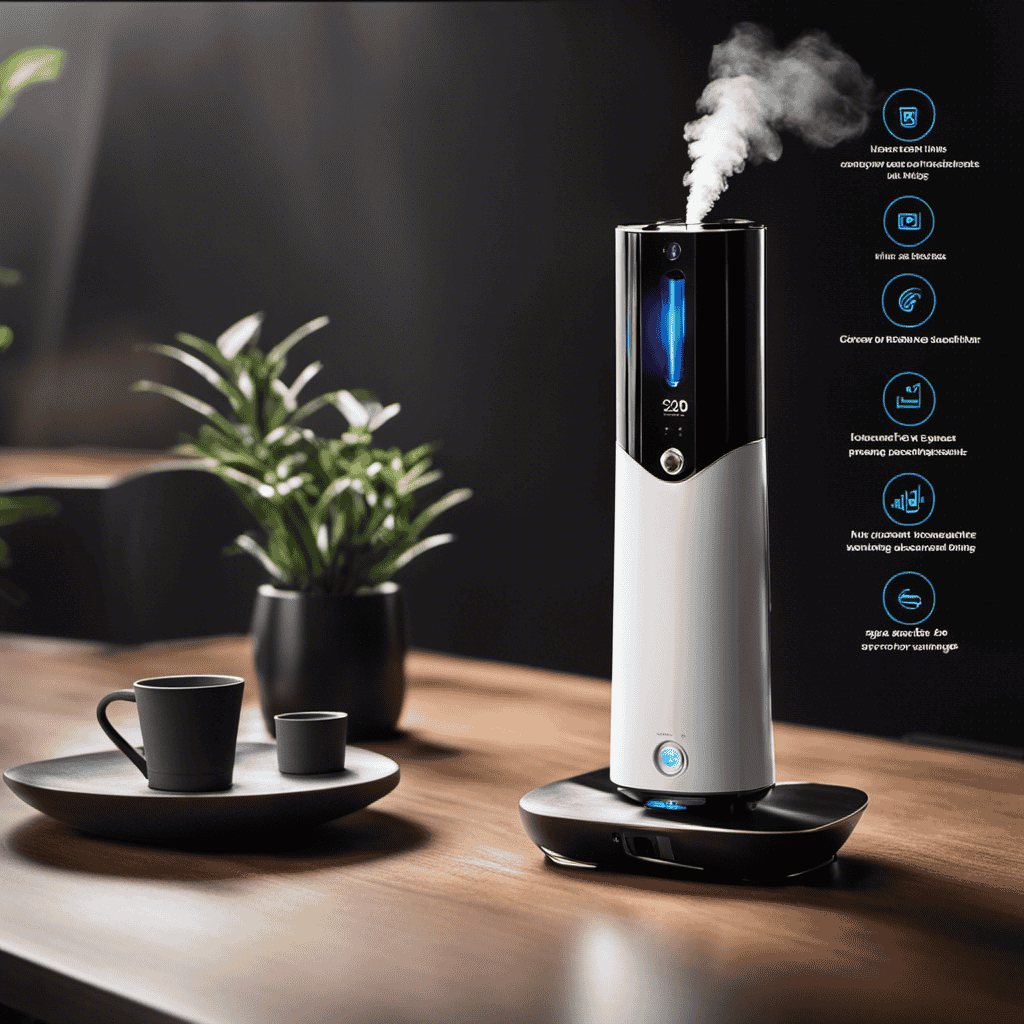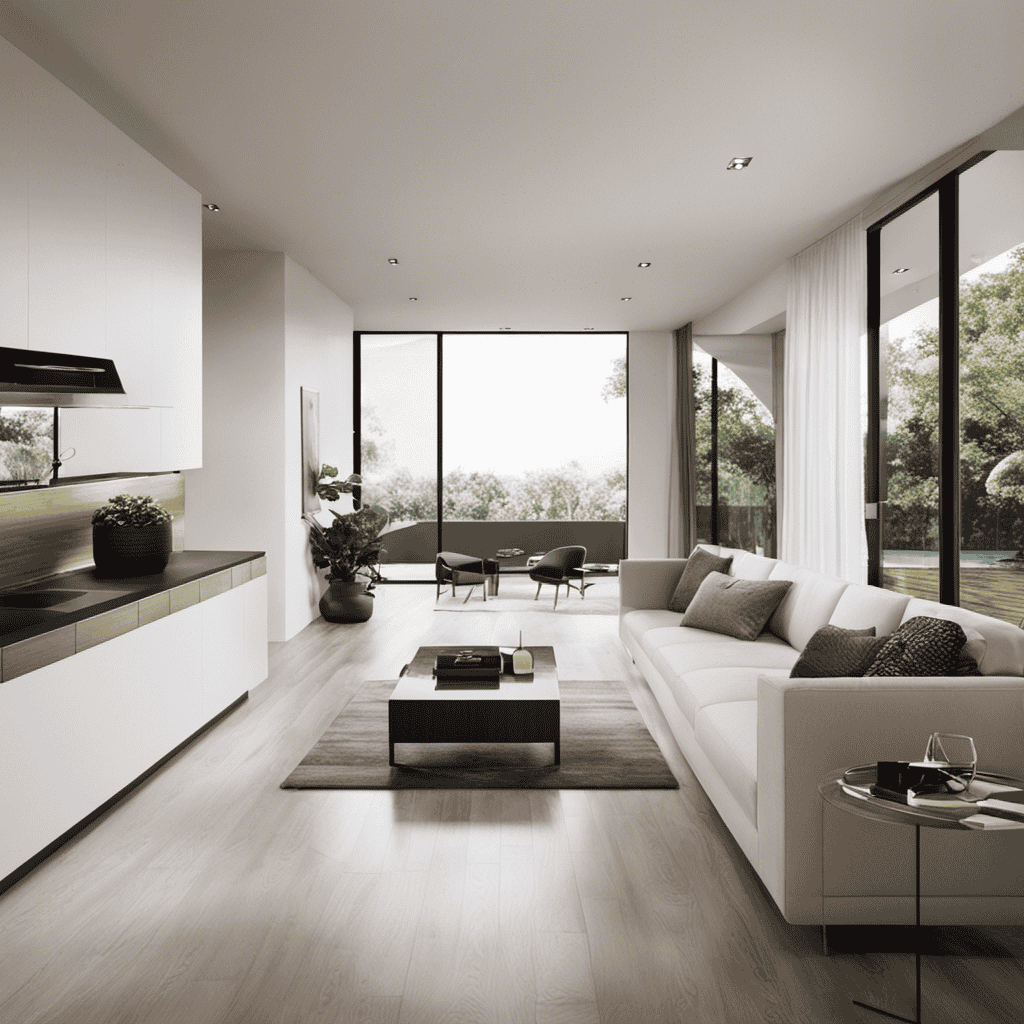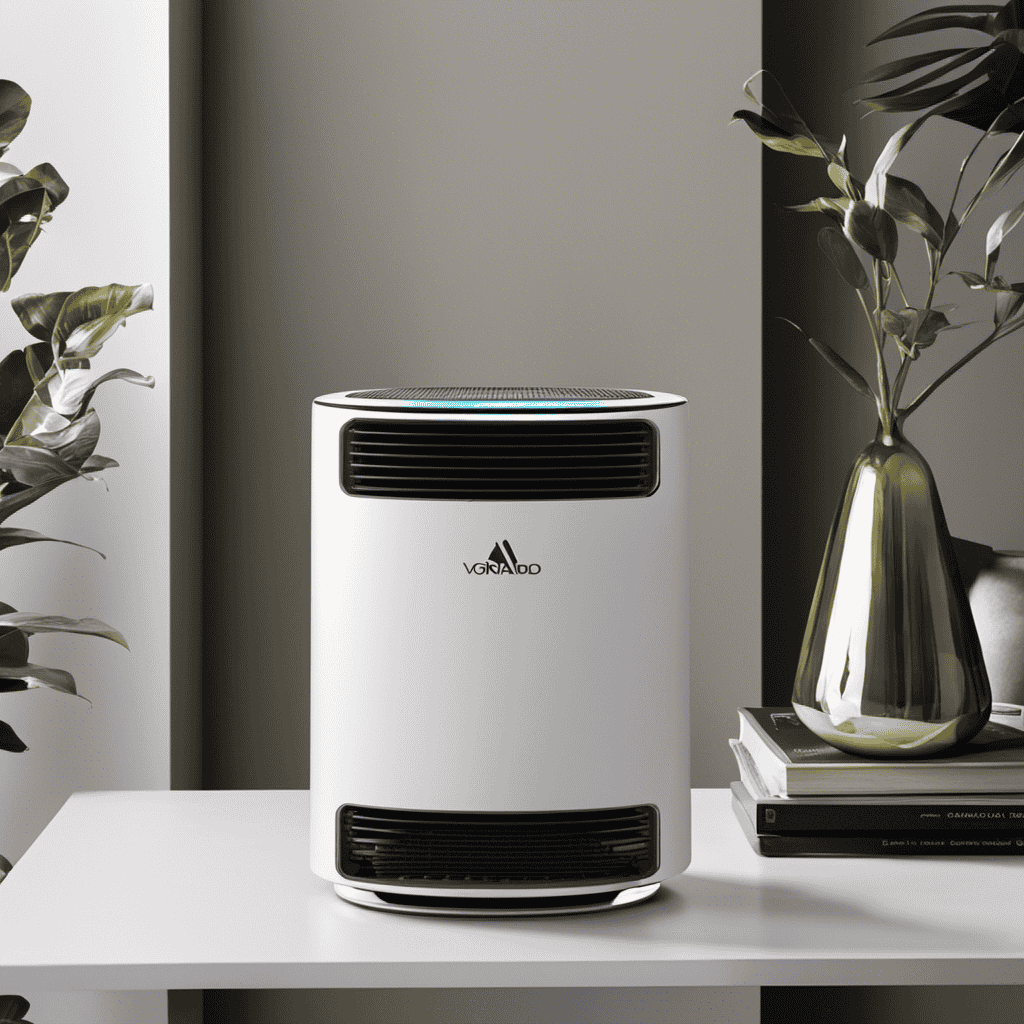As someone who uses vaping devices, I’ve consistently been interested in understanding how they affect the quality of air indoors.
Did you know that the air inside our homes can be up to five times more polluted than the air outside? That’s where vape air purifiers come in. They are designed to filter out harmful substances, such as nicotine, formaldehyde, and volatile organic compounds (VOCs), ensuring cleaner and fresher air.
In this article, we will explore the science behind vape air purifiers and how they work to improve the air quality in your space.
Key Takeaways
- Vape air purifiers use a combination of filtration and ionization techniques to filter out harmful substances like nicotine, formaldehyde, and VOCs.
- The filter system in vape air purifiers typically includes a pre-filter, a HEPA filter, and an activated carbon filter, which work together to trap and remove contaminants.
- The activated carbon filter in vape air purifiers absorbs odors and chemicals, while the HEPA filter captures tiny particles, including harmful aerosols and fine particles.
- Vape air purifiers with carbon filters effectively improve air quality by trapping harmful substances and eliminating unpleasant odors, creating a healthier environment for vaping.
The Science Behind Vape Air Purifiers
You’ll be amazed at the scientific principles behind how vape air purifiers work. Understanding air purification is essential to grasp the health benefits of clean air.
Vape air purifiers use a combination of filtration and ionization techniques to remove harmful particles from the air. Firstly, the air passes through a pre-filter that traps larger particles like dust and pet dander.
Then, the air moves through an activated carbon filter that absorbs odors and chemicals. Finally, the air passes through an ionizer that charges the particles, causing them to stick to a collection plate or be attracted to oppositely charged surfaces.
This process effectively removes pollutants, allergens, and even viruses from the air, promoting cleaner and healthier indoor environments.
With vape air purifiers, you can breathe easier and enjoy the numerous health benefits of clean air.
Understanding the Technology of Vape Air Purifiers
To understand how this technology functions, you can start by examining the inner workings of vape air purifiers. These devices are designed to improve the air quality when vaping by removing harmful particles and odors.
Here’s a breakdown of how vape air purifiers work:
-
Filtration: Vape air purifiers use a combination of filters to trap and remove contaminants from the air. These filters may include a pre-filter, a HEPA filter, and an activated carbon filter. The pre-filter captures larger particles, while the HEPA filter removes tiny particles like dust and allergens. The activated carbon filter absorbs odors and chemicals.
-
Air Circulation: Vape air purifiers have a fan that draws in air from the surrounding environment. This air is then passed through the filters, where contaminants are trapped. The purified air is then released back into the room, providing a cleaner vaping experience.
-
Maintenance: Regular maintenance is essential for vape air purifiers to function effectively. This may involve replacing filters, cleaning the device, and ensuring proper airflow. Following the manufacturer’s instructions is crucial for optimal performance and longevity.
Key Components of a Vape Air Purifier
When using a vape air purifier, it’s important to understand the key components that make up this device.
The main components of a vape air purifier include a filter system, a fan, and a power source.
The filter system is responsible for capturing and removing harmful particles and chemicals from the air. It typically consists of a pre-filter, a HEPA filter, and an activated carbon filter.
The fan helps to circulate the air through the filter system, ensuring that all contaminants are captured and removed.
The power source provides the necessary energy to run the fan and operate the filtration process.
Together, these components work in harmony to effectively purify the air and create a healthier vaping environment.
How Vape Air Purifiers Filter Out Harmful Substances
When it comes to vaping, it’s important to consider the potential harmful chemicals that can be released into the air. A vape air purifier plays a crucial role in filtering out these substances and promoting cleaner air.
In this discussion, we will explore how these purifiers work, the purification process they employ, and the numerous benefits of ensuring clean air while using vape devices.
Filtering Harmful Vape Chemicals
Filtering harmful vape chemicals is a key function of the vape air purifier. As an owner of a vape air purifier, I am well aware of the importance of keeping the air clean from potentially harmful substances.
The device utilizes advanced cleaning techniques to ensure that the air we breathe is free from any health risks associated with vaping. Here are three ways in which the vape air purifier filters out harmful vape chemicals:
-
Activated Carbon Filter: This filter is designed to trap and absorb harmful chemicals, such as formaldehyde and benzene, that are released during vaping.
-
HEPA Filter: The high-efficiency particulate air (HEPA) filter captures tiny particles, including harmful aerosols and fine particles, providing clean and fresh air.
-
UV-C Light Technology: The purifier uses UV-C light to neutralize bacteria, viruses, and other microorganisms that may be present in the vape aerosol.
By employing these effective filtration methods, the vape air purifier ensures that the air we breathe is free from harmful vape chemicals.
Now, let’s dive into the purification process explained in detail.
Purification Process Explained
To understand how the purification process works, you can start by examining the three main components of the vape air purifier. These components work together to improve air quality and remove harmful particles.
The first component is the pre-filter, which captures larger particles like dust and pollen. This helps to prolong the lifespan of the other filters.
The second component is the activated carbon filter. This filter is designed to absorb and remove harmful chemicals and odors from the air.
The third component is the HEPA filter. This filter is highly efficient at capturing tiny particles, such as smoke and allergens.
By combining these three components, the vape air purifier effectively improves air quality and removes harmful particles, providing a cleaner and healthier environment.
| Component | Function |
|---|---|
| Pre-filter | Captures larger particles |
| Activated Carbon Filter | Absorbs and removes harmful chemicals and odors |
| HEPA Filter | Captures tiny particles such as smoke and allergens |
Benefits of Clean Air
Now that we understand how the purification process works, let’s explore the benefits of clean air. As someone who has struggled with allergies in the past, I can attest to the positive impact clean air can have on our overall well-being.
-
Improved Breathing: Breathing in clean air can do wonders for our respiratory system. Without the presence of harmful particles and pollutants, our lungs can function optimally, allowing for better oxygen exchange and improved lung capacity.
-
Reduced Allergies: Clean air can significantly reduce allergies by filtering out common allergens such as dust mites, pollen, and pet dander. This means fewer sneezing fits, itchy eyes, and congestion, allowing us to enjoy life without the constant discomfort of allergies.
-
Enhanced Quality of Life: Breathing in clean air not only improves our physical health but also enhances our mental well-being. With less exposure to toxins and pollutants, we can experience higher energy levels, improved sleep, and an overall better quality of life.
The Role of HEPA Filters in Vape Air Purifiers
HEPA filters play a crucial role in how vape air purifiers operate. These filters are designed to remove particulate matter from the air, including harmful substances emitted from vaping.
HEPA stands for High-Efficiency Particulate Air, and the name itself suggests their effectiveness in filtering out tiny particles. The efficiency of HEPA filters is measured by their ability to capture particles as small as 0.3 microns with an efficiency of 99.97%. This means that these filters can effectively trap even the tiniest particles present in the vape aerosols.
By removing these particles, HEPA filters help to improve the air quality and reduce the potential health risks associated with vaping.
It is important to regularly clean or replace these filters to maintain their efficiency and ensure optimal performance of vape air purifiers.
How Activated Carbon Filters Work in Vape Air Purifiers
When it comes to vape air purifiers, one important aspect to consider is the effectiveness of activated carbon filters. These filters play a crucial role in removing odor caused by vaping, as they have the ability to trap and absorb volatile organic compounds (VOCs) responsible for the unpleasant smell.
Additionally, activated carbon filters are designed to absorb vape toxins, such as formaldehyde and acrolein, improving the overall air quality in your space. Understanding how these filters work is essential in choosing the right vape air purifier for maximum effectiveness.
Carbon Filter Odor Removal
If you’re looking to eliminate odors from vaping, the carbon filter in the air purifier is what you need. Here’s how it works:
-
Absorption: The carbon filter contains tiny pores that trap and absorb odor-causing molecules from the air. It acts like a sponge, pulling in and holding onto the unwanted smells.
-
Chemical Reaction: The carbon material in the filter undergoes a process called adsorption, where the odorous compounds stick to its surface. This chemical reaction helps to neutralize and eliminate the odors effectively.
-
Long-lasting Effect: Carbon filters are known for their longevity. They can efficiently remove odors for an extended period before needing replacement, making them a cost-effective solution for odor elimination in vaping areas.
Vape Toxin Absorption
The carbon filter in an air purifier effectively absorbs and neutralizes toxins from vaping, ensuring a safer and healthier environment. Vaping has gained popularity in recent years, but it’s important to understand the potential health risks associated with it. Vape toxins, such as formaldehyde, acrolein, and volatile organic compounds (VOCs), can have detrimental effects on our respiratory system. The carbon filter in an air purifier acts as a powerful defense mechanism against these toxins. It works by using activated carbon, which has a high surface area and porous structure, to trap and absorb the harmful substances. The filter’s large surface area allows for maximum contact with the toxins, effectively removing them from the air we breathe. This toxin absorption mechanism is crucial in reducing the health risks associated with vaping.
| Toxin | Health Effects |
|---|---|
| Formaldehyde | Respiratory irritation |
| Acrolein | Lung damage |
| Volatile Organic Compounds (VOCs) | Eye, nose, and throat irritation |
Air Purifier Effectiveness
By incorporating an air purifier with a carbon filter into your vaping environment, you can effectively neutralize toxins and create a healthier space for yourself and others.
The efficiency of an air purifier in improving air quality is remarkable. Here are three ways in which it works:
-
Filtration: The carbon filter in the air purifier traps harmful substances such as volatile organic compounds (VOCs) and other chemicals released during vaping. This prevents these toxins from circulating in the air and being inhaled by you and those around you.
-
Odor elimination: Vaping can leave behind unpleasant smells. An air purifier with a carbon filter helps remove these odors, leaving the air fresh and clean.
-
Reduction of particulate matter: Vaping releases tiny particles into the air, known as PM2.5. These particles can be harmful when inhaled. An air purifier with a HEPA filter can effectively capture and remove these particles, improving the overall air quality.
The Importance of Airflow in Vape Air Purifiers
To understand the importance of airflow in vape air purifiers, you need to know how it works. Airflow efficiency plays a significant role in the overall performance of these devices and has a direct impact on air quality.
When vaping, harmful particles and chemicals are released into the air. A vape air purifier works by drawing in the contaminated air and passing it through a series of filters. The airflow within the purifier determines how effectively these filters can capture and remove these harmful substances, ensuring cleaner air for those nearby.
Maintaining and Cleaning Your Vape Air Purifier
Make sure you regularly clean and maintain your vape air purifier for optimal performance. Here are three essential cleaning techniques for vape air purifier maintenance:
-
Clean the filter: The filter is the heart of your vape air purifier. Over time, it can become clogged with dirt, dust, and residue from vaping. To clean it, gently remove the filter and rinse it with warm water. Let it dry completely before reinserting it into the purifier.
-
Wipe down the exterior: Dust and grime can accumulate on the exterior of your vape air purifier, affecting its overall performance. Use a soft, damp cloth to wipe down the exterior regularly. Avoid using harsh chemicals or abrasive materials that could damage the purifier.
-
Check the airflow: Proper airflow is crucial for the efficient operation of your vape air purifier. Regularly inspect the vents and air intake to ensure they are free of obstructions. If you notice any blockages, gently remove them to restore optimal airflow.
Benefits of Using a Vape Air Purifier in Your Space
Improve the air quality in your space by using a vape air purifier. These devices efficiently remove harmful particles and odors, making them a great addition to any space. One of the main advantages of vape air purifiers is their ability to remove harmful particles from the air. This includes smoke, allergens, and pollutants, which can be particularly beneficial for individuals with respiratory issues or allergies.
Another advantage of vape air purifiers is their ability to eliminate unpleasant odors. Whether it’s cooking smells, pet odors, or cigarette smoke, these devices can effectively get rid of them, leaving your space smelling fresh and clean.
When choosing a vape air purifier, there are a few factors to consider. The size of your space is important, as you’ll want a purifier that can effectively clean the air in the entire area. The type of filtration system used is also crucial, as different systems have different capabilities. Lastly, don’t forget about maintenance requirements. Regular cleaning or filter replacements are necessary to ensure optimal performance and longevity of your vape air purifier.
Frequently Asked Questions
How Much Electricity Does a Vape Air Purifier Consume?
The electricity consumption of a vape air purifier depends on various factors such as the model and usage patterns. It is important to consider the energy usage of the device to make informed decisions about its operation.
Can a Vape Air Purifier Remove the Smell of Smoke?
Can a vape air purifier remove the smell of smoke? Yes, it can! The effectiveness of a vape air purifier in eliminating smoke odor is one of the many benefits of using this device.
Does a Vape Air Purifier Eliminate All Harmful Chemicals From the Air?
Yes, a vape air purifier can effectively reduce indoor air pollution by removing harmful chemicals. It has the potential to provide health benefits by improving air quality and reducing exposure to toxins.
Are Vape Air Purifiers Suitable for Use in Small Rooms?
Yes, vape air purifiers are suitable for use in small rooms. They are effective in removing harmful chemicals from the air, including different types of smoke. I have found them to be beneficial in large spaces as well.
Can a Vape Air Purifier Be Used in Conjunction With Other Air Filtration Systems?
Yes, a vape air purifier can be used with other air filtration systems. It enhances compatibility and effectiveness in large spaces. Together, they create a powerful combination, ensuring clean and fresh air for a healthier environment.
Conclusion
In conclusion, using a vape air purifier is a smart choice for anyone looking to improve the air quality in their space.
Not only does it effectively filter out harmful substances, but it also utilizes advanced technology to ensure maximum efficiency.
With key components like HEPA and activated carbon filters, you can trust that your air is being thoroughly cleaned.
By maintaining and cleaning your vape air purifier regularly, you can enjoy the benefits of fresher, healthier air.
Don’t wait, invest in a vape air purifier today and breathe easier tomorrow.










